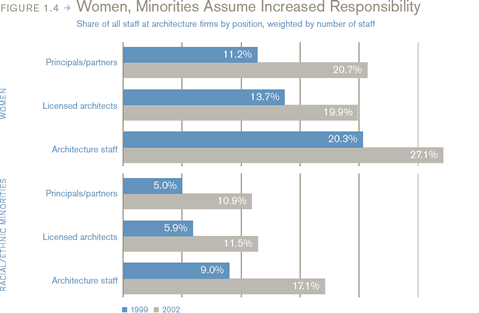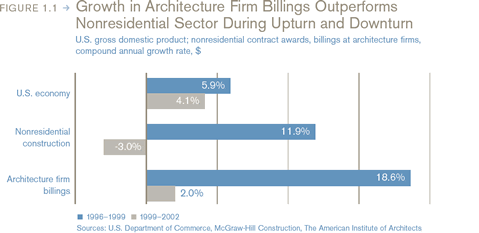

2003 Firm Survey Shows
Women, Minorities Make Impressive Gains Despite Lackluster, Recession-Hit
Economy
Newly released figures document recent trends
in the profession
As held true in the booming 1990s, economic expansions generally produce unusually strong periods of growth for cyclical sectors of the economy, such as construction. What goes up, however, must come down, and the concurrent truism that economic recessions generally lead to equally strong downturns in these sectors has also held, according to the newly released Business of Architecture: the 2003 AIA Firm Survey.
 The
newly released survey, a comprehensive study of the architecture industry
based on a survey of nearly 1,400 member firms by the AIA Economics and
Markets Research Department, examines data from 1999–2002. During
this period, which encompasses the 2001 recession, the nonresidential
construction sector in general and architecture firms in particular underperformed
the national economy, reports AIA Chief Economist Kermit Baker, PhD, Hon.
AIA, in the survey’s executive summary. So, although the economy
grew an average of 4 percent per year (before inflation adjustments) over
this three-year period, nonresidential construction contracts declined
by an average of 3 percent per year, and billings at architecture firms
increased by just 2 percent.
The
newly released survey, a comprehensive study of the architecture industry
based on a survey of nearly 1,400 member firms by the AIA Economics and
Markets Research Department, examines data from 1999–2002. During
this period, which encompasses the 2001 recession, the nonresidential
construction sector in general and architecture firms in particular underperformed
the national economy, reports AIA Chief Economist Kermit Baker, PhD, Hon.
AIA, in the survey’s executive summary. So, although the economy
grew an average of 4 percent per year (before inflation adjustments) over
this three-year period, nonresidential construction contracts declined
by an average of 3 percent per year, and billings at architecture firms
increased by just 2 percent.
Women, minorities make impressive gains
Some of the most encouraging news from the 2003 survey centers on the
career-advancement opportunities women and minorities have gained during
a period of economic weakness. As of 2002, women composed 27 percent of
architecture staff at firms, up from 20 percent in 1999. Racial and ethnic
minorities accounted for 17 percent, up from 9 percent three years prior.
The figures for registered architects are just as strong: Women represented 20 percent in 2002, up from under 14 percent, while racial and ethnic minorities represented more than 11 percent in 2002, up from 6 percent. Some of this increase is due to simple demographics. For the past two decades, women, as well as racial and ethnic minorities, have become a growing share of the nation’s workforce. Likewise, architecture programs have attracted growing numbers of women and racial and ethnic minorities, and these program graduates have made growing shares of staff at firms, albeit unsteadily.
The biggest recent change, however, is the rate at which women and racial and ethnic minorities have moved into leadership positions at firms. In 2002, women accounted for almost 21 percent of principals and partners at firms, a figure that grew from 11 percent in 1999. Likewise, racial and ethnic minorities accounted for 11 percent of principals and partners in 2002, up from 5 percent in 1999 (figure 1.4).
Changing nature of firms
Although growth in billings at architecture firms slowed dramatically
from the 1990s, the firms still managed to outperform the broader nonresidential
sector of construction. There are at least three key reasons for this.
- A significant minority of billings at firms is generated by residential projects. Over both of these periods, low interest rates produced stronger growth in new-home construction, and residential remodeling compared with nonresidential activity (figure 1.1).
- Firms are changing their structures to offer a broader range of services. Firms are increasingly integrating other design professionals to create multidisciplinary design firms, which generates increased billings per construction project.
- Related to this changing structure of firms is the changing range of services offered to clients. As architecture firms expand their service offerings, particularly in areas that are not directly related to construction activity, firm billings can increase proportionately faster than the underlying construction activity (figure 1.2).
Honing firm offerings
The 2003 survey also shows that firms appear to be choosing these additional
services more strategically. Rather than focusing on new service areas
and new client categories to serve, many firms returned their focus to
more traditional services. During the recent economic downturn, billings
at firms slowed to a crawl. In this competitive environment, many firms
began to focus their service offerings. The share of revenue from basic
design services increased from 62 percent in 1999 to 65 percent in 2002.
This increase came after dramatic declines in the share of revenues from
basic design services during the 1990s.
Other services that increased their share of billings at firms were planning and predesign services and expanded design and nonarchitectural design services (e.g., interior design and engineering). The share of billings for construction and postconstruction services declined over this period because efforts were focused on the predesign and design phases. Firms may expand back into construction and postconstruction as the economy improves. However, most firms report that redesign and design services offer the greatest opportunities for profitability.
Copyright 2003 The American Institute of Architects.
All rights reserved. Home Page ![]()
![]()



